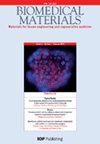壳聚糖/聚乙烯醇抗菌海绵材料的制备与表征
IF 3.7
3区 医学
Q2 ENGINEERING, BIOMEDICAL
引用次数: 0
摘要
本研究采用冷冻干燥法制造壳聚糖(CS)和聚乙烯醇(PVA)海绵。为增强其抗菌性能,添加了姜黄素和纳米银(Cur@Ag)以实现协同抗菌。添加姜黄素和纳米银后,复合海绵敷料(CS-PVA-Cur@Ag)的机械性能得到了改善。复合海绵敷料的孔隙率达到 80%,有利于药物的释放,同时具有良好的吸水性和保水率。纳米银的直径为 50-80 nm,是杀灭细菌的最佳直径。用大肠杆菌和金黄色葡萄球菌进行的抗菌测试表明,只需少量纳米银就能消灭细菌。最后,在大鼠全厚皮肤伤口模型中,复合海绵敷料能在短时间内促进伤口愈合。总之,CS-PVA-Cur@Ag 伤口敷料可以防止细菌感染并加速伤口愈合。因此,它在伤口敷料方面具有很高的潜在应用价值。本文章由计算机程序翻译,如有差异,请以英文原文为准。
Preparation and characterization of chitosan/polyvinyl alcohol antibacterial sponge materials
This study utilized the freeze-drying method to create a chitosan (CS) and polyvinyl alcohol (PVA) sponge. To enhance its antibacterial properties, curcumin and nano silver (Cur@Ag) were added for synergistic antibacterial. After adding curcumin and nano silver, the mechanical properties of the composite sponge dressing (CS-PVA-Cur@Ag) were improved. The porosity of the composite sponge dressing was closed to 80%, which was helpful for drug release, and it had good water absorption and water retention rate. The nano silver diameter was 50–80 nm, which was optimal for killing bacteria. Antibacterial tests used Escherichia coli and Staphylococcus aureus demonstrated that little nano silver was required to eliminate bacteria. Finally, in the rat full-thickness skin wound model, the composite sponge dressing can promote wound healing in a short time. In summary, CS-PVA-Cur@Ag wound dressing could protect from bacterial infection and accelerate wound healing. Thus, it had high potential application value for wound dressing.
求助全文
通过发布文献求助,成功后即可免费获取论文全文。
去求助
来源期刊

Biomedical materials
工程技术-材料科学:生物材料
CiteScore
6.70
自引率
7.50%
发文量
294
审稿时长
3 months
期刊介绍:
The goal of the journal is to publish original research findings and critical reviews that contribute to our knowledge about the composition, properties, and performance of materials for all applications relevant to human healthcare.
Typical areas of interest include (but are not limited to):
-Synthesis/characterization of biomedical materials-
Nature-inspired synthesis/biomineralization of biomedical materials-
In vitro/in vivo performance of biomedical materials-
Biofabrication technologies/applications: 3D bioprinting, bioink development, bioassembly & biopatterning-
Microfluidic systems (including disease models): fabrication, testing & translational applications-
Tissue engineering/regenerative medicine-
Interaction of molecules/cells with materials-
Effects of biomaterials on stem cell behaviour-
Growth factors/genes/cells incorporated into biomedical materials-
Biophysical cues/biocompatibility pathways in biomedical materials performance-
Clinical applications of biomedical materials for cell therapies in disease (cancer etc)-
Nanomedicine, nanotoxicology and nanopathology-
Pharmacokinetic considerations in drug delivery systems-
Risks of contrast media in imaging systems-
Biosafety aspects of gene delivery agents-
Preclinical and clinical performance of implantable biomedical materials-
Translational and regulatory matters
 求助内容:
求助内容: 应助结果提醒方式:
应助结果提醒方式:


